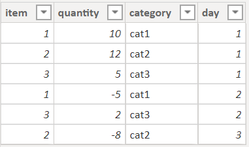- Power BI forums
- Updates
- News & Announcements
- Get Help with Power BI
- Desktop
- Service
- Report Server
- Power Query
- Mobile Apps
- Developer
- DAX Commands and Tips
- Custom Visuals Development Discussion
- Health and Life Sciences
- Power BI Spanish forums
- Translated Spanish Desktop
- Power Platform Integration - Better Together!
- Power Platform Integrations (Read-only)
- Power Platform and Dynamics 365 Integrations (Read-only)
- Training and Consulting
- Instructor Led Training
- Dashboard in a Day for Women, by Women
- Galleries
- Community Connections & How-To Videos
- COVID-19 Data Stories Gallery
- Themes Gallery
- Data Stories Gallery
- R Script Showcase
- Webinars and Video Gallery
- Quick Measures Gallery
- 2021 MSBizAppsSummit Gallery
- 2020 MSBizAppsSummit Gallery
- 2019 MSBizAppsSummit Gallery
- Events
- Ideas
- Custom Visuals Ideas
- Issues
- Issues
- Events
- Upcoming Events
- Community Blog
- Power BI Community Blog
- Custom Visuals Community Blog
- Community Support
- Community Accounts & Registration
- Using the Community
- Community Feedback
Register now to learn Fabric in free live sessions led by the best Microsoft experts. From Apr 16 to May 9, in English and Spanish.
- Power BI forums
- Forums
- Get Help with Power BI
- Desktop
- Cumulative measure and empty legend in barchart
- Subscribe to RSS Feed
- Mark Topic as New
- Mark Topic as Read
- Float this Topic for Current User
- Bookmark
- Subscribe
- Printer Friendly Page
- Mark as New
- Bookmark
- Subscribe
- Mute
- Subscribe to RSS Feed
- Permalink
- Report Inappropriate Content
Cumulative measure and empty legend in barchart
Hello !
I am currently working on a inventory dashboard. I have a transaction table (day, item, category, quantity) like this one

And I would like to display the inventory value per category for each day.
I have created a cumulated measure to compute the total inventory per day:
cumulated_quantity =
CALCULATE(
SUM('transactions'[quantity]),
FILTER(
ALLSELECTED('transactions'[day]),
ISONORAFTER('transactions'[day], MAX('transactions'[day]), DESC)
)
)
When I display the full inventory per day I see the expected result (day 1: 27, day 2: 24, day 3: 16)

But when I apply the category as a legend, I notice that if there is no transaction for a given day and category, the category is not displayed in the chart:
day 1: 27 , day 2: 12, day 3: 4

How can I do to display the correct inventory for those days ?
Thanks for your help !
Solved! Go to Solution.
- Mark as New
- Bookmark
- Subscribe
- Mute
- Subscribe to RSS Feed
- Permalink
- Report Inappropriate Content
Hi @phaidara ,
You will need to create an extra category table with no relationship with transactions table.
category = DISTINCT(transactions[category])Then use below formula to get the result.
Measure = CALCULATE(SUM(transactions[quantity]),FILTER(ALLSELECTED(transactions),transactions[day]<=MAX(transactions[day])&&transactions[category]=SELECTEDVALUE('category'[category])))
Best Regards,
Jay
If this post helps, then please consider Accept it as the solution to help the other members find it.
- Mark as New
- Bookmark
- Subscribe
- Mute
- Subscribe to RSS Feed
- Permalink
- Report Inappropriate Content
Hi @phaidara ,
You will need to create an extra category table with no relationship with transactions table.
category = DISTINCT(transactions[category])Then use below formula to get the result.
Measure = CALCULATE(SUM(transactions[quantity]),FILTER(ALLSELECTED(transactions),transactions[day]<=MAX(transactions[day])&&transactions[category]=SELECTEDVALUE('category'[category])))
Best Regards,
Jay
If this post helps, then please consider Accept it as the solution to help the other members find it.
- Mark as New
- Bookmark
- Subscribe
- Mute
- Subscribe to RSS Feed
- Permalink
- Report Inappropriate Content
- Mark as New
- Bookmark
- Subscribe
- Mute
- Subscribe to RSS Feed
- Permalink
- Report Inappropriate Content
@phaidara , Try like
cumulated_quantity =
CALCULATE(
SUM('transactions'[quantity]),
FILTER(
ALLSELECTED('transactions'),
'transactions'[day]>= max('transactions'[day])
&& 'transactions'[category]= max('transactions'[category])
)
)
Microsoft Power BI Learning Resources, 2023 !!
Learn Power BI - Full Course with Dec-2022, with Window, Index, Offset, 100+ Topics !!
Did I answer your question? Mark my post as a solution! Appreciate your Kudos !! Proud to be a Super User! !!
- Mark as New
- Bookmark
- Subscribe
- Mute
- Subscribe to RSS Feed
- Permalink
- Report Inappropriate Content
Hi @amitchandak !
Thank you for your quick reply !
I've tried your solution but it does not seem to work.
Here is the new result that i got when i copied:
Helpful resources

Microsoft Fabric Learn Together
Covering the world! 9:00-10:30 AM Sydney, 4:00-5:30 PM CET (Paris/Berlin), 7:00-8:30 PM Mexico City

Power BI Monthly Update - April 2024
Check out the April 2024 Power BI update to learn about new features.

| User | Count |
|---|---|
| 114 | |
| 99 | |
| 82 | |
| 70 | |
| 61 |
| User | Count |
|---|---|
| 149 | |
| 114 | |
| 107 | |
| 89 | |
| 67 |

